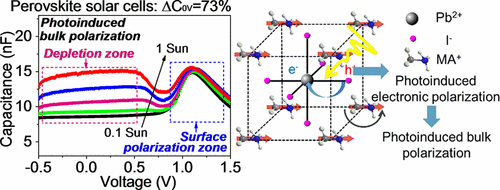Our official English website, www.x-mol.net, welcomes your
feedback! (Note: you will need to create a separate account there.)
Photoinduced Bulk Polarization and Its Effects on Photovoltaic Actions in Perovskite Solar Cells
ACS Nano ( IF 15.8 ) Pub Date : 2017-11-07 00:00:00 , DOI: 10.1021/acsnano.7b06413 Ting Wu,Liam Collins,Jia Zhang,Pei-Ying Lin,Mahshid Ahmadi,Stephen Jesse,Bin Hu
ACS Nano ( IF 15.8 ) Pub Date : 2017-11-07 00:00:00 , DOI: 10.1021/acsnano.7b06413 Ting Wu,Liam Collins,Jia Zhang,Pei-Ying Lin,Mahshid Ahmadi,Stephen Jesse,Bin Hu

|
This article reports an experimental demonstration of photoinduced bulk polarization in hysteresis-free methylammonium (MA) lead-halide perovskite solar cells [ITO/PEDOT:PSS/perovskite/PCBM/PEI/Ag]. An anomalous capacitance–voltage (CV) signal is observed as a broad “shoulder” in the depletion region from −0.5 to +0.5 V under photoexcitation based on CV measurements where a dc bias is gradually scanned to continuously drift mobile ions in order to detect local polarization under a low alternating bias (50 mV, 5 kHz). Essentially, gradually scanning the dc bias and applying a low alternating bias can separately generate continuously drifting ions and a bulk CV signal from local polarization under photoexcitation. Particularly, when the device efficiency is improved from 12.41% to 18.19% upon chlorine incorporation, this anomalous CV signal can be enhanced by a factor of 3. This anomalous CV signal can be assigned as the signature of photoinduced bulk polarization by distinguishing from surface polarization associated with interfacial charge accumulation. Meanwhile, replacing easy-rotational MA+ with difficult-rotational formamidinium (FA+) cations largely minimizes such anomalous CV signal, suggesting that photoinduced bulk polarization relies on the orientational freedom of dipolar organic cations. Furthermore, a Kelvin probe force microscopy study shows that chlorine incorporation can suppress the density of charged defects and thus enhances photoinduced bulk polarization due to the reduced screening effect from charged defects. A bias-dependent photoluminescence study indicates that increasing bulk polarization can suppress carrier recombination by decreasing charge capture probability through the Coulombic screening effect. Clearly, our studies provide an insightful understanding of photoinduced bulk polarization and its effects on photovoltaic actions in perovskite solar cells.
中文翻译:

钙钛矿型太阳能电池中的光诱导体极化及其对光伏作用的影响
本文报道了无磁滞的甲基铵(MA)卤化钙钛矿型太阳能电池[ITO / PEDOT:PSS /钙钛矿/ PCBM / PEI / Ag]中光诱导的体极化的实验演示。根据CV测量,在光激励下,在-0.5至+0.5 V的耗尽区中,观察到一个异常的电容-电压(CV)信号为宽“肩”,其中CV测量是逐渐扫描直流偏置以连续漂移移动离子以检测低交变偏压(50 mV,5 kHz)下的局部极化。本质上,逐渐扫描直流偏置并施加低交变偏置可以在光激发下分别从局部极化产生连续漂移的离子和大量CV信号。尤其是,加入氯后,器件效率从12.41%提高到18.19%时,该异常CV信号可以增强3倍。通过区别与界面电荷积累相关的表面极化,可以将该异常CV信号指定为光诱导体极化的特征。同时,替换易旋转的MA+与难以旋转甲脒(FA +)阳离子基本上最小化这些异常CV信号,这表明光诱导体极化依赖于偶极有机阳离子的取向的自由度。此外,开尔文探针力显微镜研究表明,由于减少了对带电缺陷的屏蔽作用,氯的混入可以抑制带电缺陷的密度,从而增强光诱导的体极化。偏倚相关的光致发光研究表明,增加体极化可通过库仑屏蔽效应降低电荷捕获概率,从而抑制载流子复合。显然,我们的研究提供了对光诱导的体极化及其对钙钛矿太阳能电池中光伏作用的影响的深刻理解。
更新日期:2017-11-08
中文翻译:

钙钛矿型太阳能电池中的光诱导体极化及其对光伏作用的影响
本文报道了无磁滞的甲基铵(MA)卤化钙钛矿型太阳能电池[ITO / PEDOT:PSS /钙钛矿/ PCBM / PEI / Ag]中光诱导的体极化的实验演示。根据CV测量,在光激励下,在-0.5至+0.5 V的耗尽区中,观察到一个异常的电容-电压(CV)信号为宽“肩”,其中CV测量是逐渐扫描直流偏置以连续漂移移动离子以检测低交变偏压(50 mV,5 kHz)下的局部极化。本质上,逐渐扫描直流偏置并施加低交变偏置可以在光激发下分别从局部极化产生连续漂移的离子和大量CV信号。尤其是,加入氯后,器件效率从12.41%提高到18.19%时,该异常CV信号可以增强3倍。通过区别与界面电荷积累相关的表面极化,可以将该异常CV信号指定为光诱导体极化的特征。同时,替换易旋转的MA+与难以旋转甲脒(FA +)阳离子基本上最小化这些异常CV信号,这表明光诱导体极化依赖于偶极有机阳离子的取向的自由度。此外,开尔文探针力显微镜研究表明,由于减少了对带电缺陷的屏蔽作用,氯的混入可以抑制带电缺陷的密度,从而增强光诱导的体极化。偏倚相关的光致发光研究表明,增加体极化可通过库仑屏蔽效应降低电荷捕获概率,从而抑制载流子复合。显然,我们的研究提供了对光诱导的体极化及其对钙钛矿太阳能电池中光伏作用的影响的深刻理解。











































 京公网安备 11010802027423号
京公网安备 11010802027423号